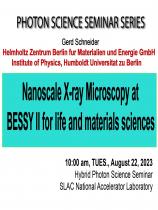Speaker: Gerd Schneider, Helmholtz Zentrum Berlin fur Materialien und Energie GmbH and Institute of Physics, Humboldt Universitat zu Berlin
Program Description:
X-ray imaging is crucial for many scientific applications, ranging from material and energy sciences to biomedicine. This broad utility arises from the intrinsically short wavelengths of X-rays coupled with their penetration power and element specific image contrast. These attributes enable nanoscale images of comparatively thick specimens. Biological X-ray microscopy yields the structural details in 3D of biological materials at the cellular level by nanoscale tomography. Entire cells to be examined in their natural state without chemical fixation, staining or physical sectioning but only with cryopreservation. High resolution cryo TEM requires a physical sectioning process of cells limiting the volume to be studied and super fluorescence microscopy requires a labeling process with fluorescence dyes. To study the interaction of viruses, nanoparticles or drugs with cells, X-ray microscopy is an ideal tool as it delivers an unbiased view into the whole cellular volume.
In microelectronics, energy storage and catalysis complex systems composed of hierarchical structures, the system's performances are dependent on the structures and properties at all lengths of scales, from atomic to microscopic and macroscopic levels. Various microscopy techniques can be utilized to reveal the structures and properties at different lengths of scales. Compared to other microscopy techniques, X-rays have the advantage of high penetration power and are capable of looking at internal structures in bulk materials with high energy resolution delivering electronic information at the nanoscale level. The HZB full-field transmission X-ray microscope at the BESSY II U41 undulator beamline allows high spectral resolution of E/ΔE=1000 in the photon energy range 0.25 – 3 keV, about 10 nm spatial resolution and field of views in the range of 10-20 μm [1-5]. With this instrument spatially-resolved NEXAFS studies for material sciences can be performed due to the high energy resolution [1,5]. Additionally, nano-tomography of cryogenic samples had demonstrated its high potential for life sciences [2,3]. In the talk, the current status of nanoscale X-ray imaging at HZB in life and materials science is presented. In addition, future directions for X-ray imaging at modern 4th generation storage rings will be discussed.
[1] P. Guttmann, C. Bittencourt, S. Rehbein, P. Umek, X. Ke, G. Van Tendeloo, C.P. Ewels, G. Schneider, Nature Photonics 6 (2012), 25-29
[2] G. Schneider, P. Guttmann, S. Heim, S. Rehbein, F. Mueller, K. Nagashima, J.B. Heymann, W.G. Müller, J.G. McNally, Nature Methods 7 (2010), 985-987
[3] A. Dupont Juhl C.W. Heegaard, S. Werner, G. Schneider, K. Krishnan, D.F. Covey, D. Wüstner,
Sci. Rep. 11 (2021), 8927
[4] Michael C A Dyhr, Mohsen Sadeghi, Ralitsa Moynova, Carolin Knappe, Burcu Kepsutlu Çakmak, Stephan Werner, Gerd Schneider, James McNally, Frank Noé, Helge Ewers, PNAS 2023 Jun 13;120(24)
[5] S. Werner,.…,G. Schneider, Small Methods (2022), 2201382





